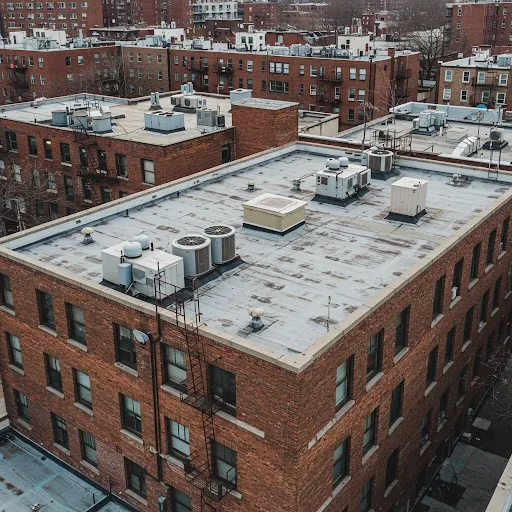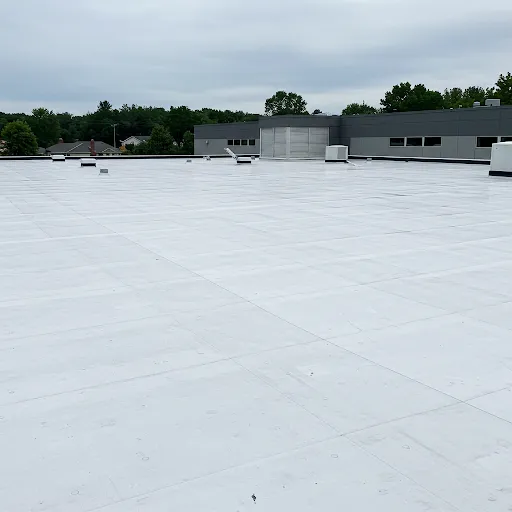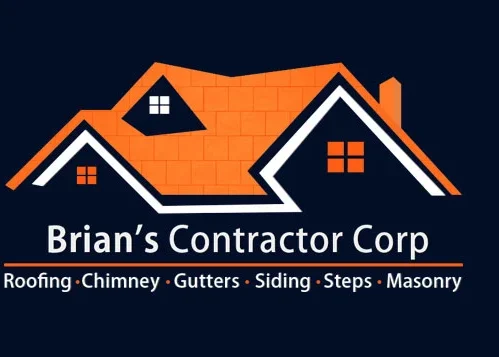
Thinking about adding a flat roof to your Bronx property? It’s a smart move. Flat roofs are popular here because they’re affordable and work well in tight urban spaces. If you’re wondering how to install a flat roof, you need to know the basic steps and materials to make sure it lasts a long time.
Learning how to install a flat roof can feel overwhelming, but with clear instructions, you can handle many parts of the job yourself. As roofing contractors serving the Bronx community for over two decades, we’ve guided countless property owners through successful installations.
This guide breaks down flat roof installation into simple steps. You’ll learn which tasks you can do yourself and when to bring in a pro. By the end, you’ll know the process, materials, and techniques needed for a solid flat roof installation in the Bronx.
Essential Materials and Tools for Flat Roof Installation in the Bronx

Before you start your flat roof installation project, every good guide to roofing will tell you it’s essential to gather the right materials and tools first. The harsh Bronx winters and hot summers demand durable materials that can withstand temperature fluctuations.
Choosing the Right Roofing Materials for Bronx Weather Conditions
When choosing the best materials for flat roof projects in the Bronx, focus on durability and how well they handle the weather.
- EPDM (Ethylene Propylene Diene Monomer) – is a rubber roofing material known for lasting over 20 years and handling the Bronx’s hot summers and cold winters very well.
- TPO (Thermoplastic Polyolefin) – is a great choice if you want an energy-efficient roof. Its white surface helps reflect heat, keeping your building cooler during hot Bronx summers.
- PVC (Polyvinyl Chloride) – Offers excellent waterproofing but comes at a higher cost than EPDM or TPO.
- Modified Bitumen – More affordable but requires professional installation and offers less longevity than synthetic options.
Required Tools and Safety Equipment Checklist
Gathering the right tools before starting will save you time and frustration. Here’s what you’ll need:
Essential Tools:
- Utility knife with hook blades
- Tape measure and chalk line
- Roofing roller
- Caulking gun
- Broom and power washer
- Hammer and roofing nails
- Pry bar (for removing old roofing)
Safety Equipment:
- Fall protection harness
- Non-slip footwear
- Safety glasses
- Work gloves
- Respirator mask (for removal of old materials)
Pro Tip: You can rent many of the roofing tools you need from Bronx hardware stores like Home Depot on Bruckner Boulevard or local equipment rental shops. This saves you from buying tools you’ll only use once or twice.
Most Bronx residential roofing projects require permits from the NYC Department of Buildings. Check with your local building department about specific requirements before beginning work to avoid potential fines.
Preparing Your Roof Surface – Critical First Steps

Understanding what is a flat roof and its structure creates the foundation for proper preparation and successful installation. Rushing this stage is a common mistake that leads to premature roof failure.
Removing Old Roofing Material Safely
If you’re undertaking a roof replacement, removal requires careful attention to both safety and structural concerns.
- Start by removing all roofing fixtures, vents, and edge metals
- Work in small sections, removing old materials down to the roof deck
- Inspect the deck thoroughly for water damage, rot, or structural issues
- Document any damage with photos for insurance purposes
For Bronx properties, be aware that NYC has strict regulations regarding roofing debris disposal. Old roofing materials must be bagged properly and may require special handling, especially if asbestos is present. Contact the NYC Department of Sanitation for guidance on proper disposal procedures.
Safety Warning: If your building is over 10 feet tall or has a steep access point, consider hiring professionals for the tear-off process. Falls are the most common cause of serious injuries during DIY roofing projects.
Proper Surface Preparation Techniques
After removing the old roofing, properly preparing the surface will help your new roof last longer. First, thoroughly clean the roof deck, removing all debris, nails, and old adhesive. Any protrusions can damage your new membrane over time. Next, address any structural issues identified during removal. This may include:
- Replacing rotted or damaged roof decking
- Reinforcing weak areas around chimneys or roof penetrations
- Ensuring proper slope for drainage (flat roofs should have at least a ¼ inch slope per foot)
Creating proper drainage is particularly important in the Bronx, where heavy rainstorms can quickly accumulate water on flat surfaces. If your roof doesn’t have adequate slope, consider installing tapered insulation to create the necessary drainage paths.
Step-by-Step Flat Roof Installation Process

Once you’ve gathered materials and prepared the surface, it’s time to learn how to build a flat roof with our step-by-step installation process.. Following these steps carefully will help ensure a watertight, long-lasting roof.
Installing Insulation and Vapor Barriers
Proper insulation is especially important for Bronx buildings, where energy costs are among the highest in the nation. Start by measuring and cutting rigid insulation boards to fit your roof area. For the Bronx climate, we suggest using insulation with an R-value of at least 30 for good energy efficiency. However, NYC building codes may have specific requirements depending on your building type
Installation steps:
- Lay down a vapor barrier directly on the clean roof deck
- Arrange insulation boards in a staggered pattern (like bricklaying)
- Leave a ¼ inch gap between boards to allow for expansion
- Secure insulation according to manufacturer specifications (typically with adhesive or mechanical fasteners)
How you attach the insulation depends on your deck type. For wood decks common in older Bronx buildings, mechanical fasteners work best. We typically recommend using adhesive for concrete decks.
Laying and Securing the Roofing Membrane
This is the most critical step in your flat roof installation and requires careful attention to detail.
- When installing a flat roof membrane, first unroll it and allow it to relax for at least 30 minutes before proceeding (this prevents wrinkles)
- Position the membrane starting from the lowest point of the roof
- Work your way up, overlapping seams according to manufacturer specifications (typically 3-6 inches)
Secure the membrane using either:
- Fully adhered method (apply adhesive to the entire surface)
- Mechanically fastened method (secure with plates and screws along seams)
- Ballasted method (weighted down with river rock or pavers)
We recommend EPDM membranes for most Bronx installations because fully adhered systems offer the best wind resistance and long-lasting durability.. Apply the adhesive according to temperature guidelines—application techniques vary significantly between hot and cold weather.
Pro Tip: When working with seam tape and adhesives, use a clean cloth dampened with the appropriate solvent to clean all surfaces before bonding. Even minor contamination can compromise adhesion.
Edge Finishing and Flashing Installation
Properly finished edges and flashing around penetrations are critical for preventing water infiltration.
For roof edges:
- Install metal drip edge around the entire perimeter
- Secure the membrane to the edge with termination bars or metal fascia
- Apply sealant along all exposed edges and screw heads
For roof penetrations (vents, chimneys, etc.):
- Cut membrane to fit snugly around the penetration
- Install appropriate flashing (either pre-formed or field-fabricated)
- Seal all edges with compatible caulk or sealant
Parapet walls, common in Bronx buildings, require special attention. The membrane should go up the parapet by at least 8 inches and be sealed with counter-flashing or reglets to stop water from getting behind
One common mistake is improper treatment of internal corners, which can lead to membrane tearing. Use pre-formed corner pieces or careful folding techniques to ensure these vulnerable areas remain watertight.
Post-Installation Considerations for Bronx Properties
Your work isn’t complete once the membrane is installed. Several critical steps remain to ensure your roof performs as expected.
Inspection and Quality Assurance Steps
Before considering your installation complete, a thorough inspection is essential.
- Visually inspect all seams and edges for proper adhesion
- Check all penetrations and flashings for secure attachment
- Look for any punctures, tears, or wrinkles in the membrane
- Perform a water test by flooding sections of the roof (if slope allows) and checking for leaks
Taking photos of your installation can help Bronx property owners with warranty claims and insurance. Most membrane manufacturers require professional inspection to validate warranties, so consider hiring a certified inspector for final verification.
The NYC Building Department may also require inspection before closing out your roofing permit. Check your permit requirements and schedule inspections as needed to ensure compliance with local codes.
Maintenance Schedule for Maximum Longevity
Even the best installation requires ongoing maintenance and occasional roof repair to achieve maximum lifespan.
Develop a maintenance schedule that includes:
- Quarterly inspections (especially after major storms)
- Clearing debris from the roof surface and drains
- Checking for membrane damage or separation
- Examining sealants and reapplying as needed
- Professional inspection annually
This flat roof installation guide is important for Bronx properties because nearby trees and pollution cause roofs to gather debris. Clogged drains are a main cause of water damage in NYC flat roofs, so it’s crucial to keep them clear, especially before winter when ice dams may form.
Your Flat Roof Installation – Final Thoughts
Contact us today to ensure your flat roof installation delivers the performance and longevity your Bronx property deserves.
Assess your skills honestly before deciding which parts of DIY flat roof installation to tackle yourself. Surface preparation and insulation installation are the most DIY-friendly, while membrane installation often benefits from professional expertise—especially for larger roofs.
Keep in mind that the cost to install a flat roof can vary, but a good installation saves you money in the long run by reducing maintenance and repair costs. Many Bronx property owners find it best to handle the preparation themselves and hire professionals for the membrane installation and finishing.
Need expert advice on your specific flat roof project? Our Bronx roofing team is available for a free consultation to help you find the best solution for your property.
See where we’ve helped other Bronx homeowners and explore local roofing demand:
CALL US AT 929-570-7620 to ensure your flat roof installation delivers the performance and longevity your Bronx property deserves.


